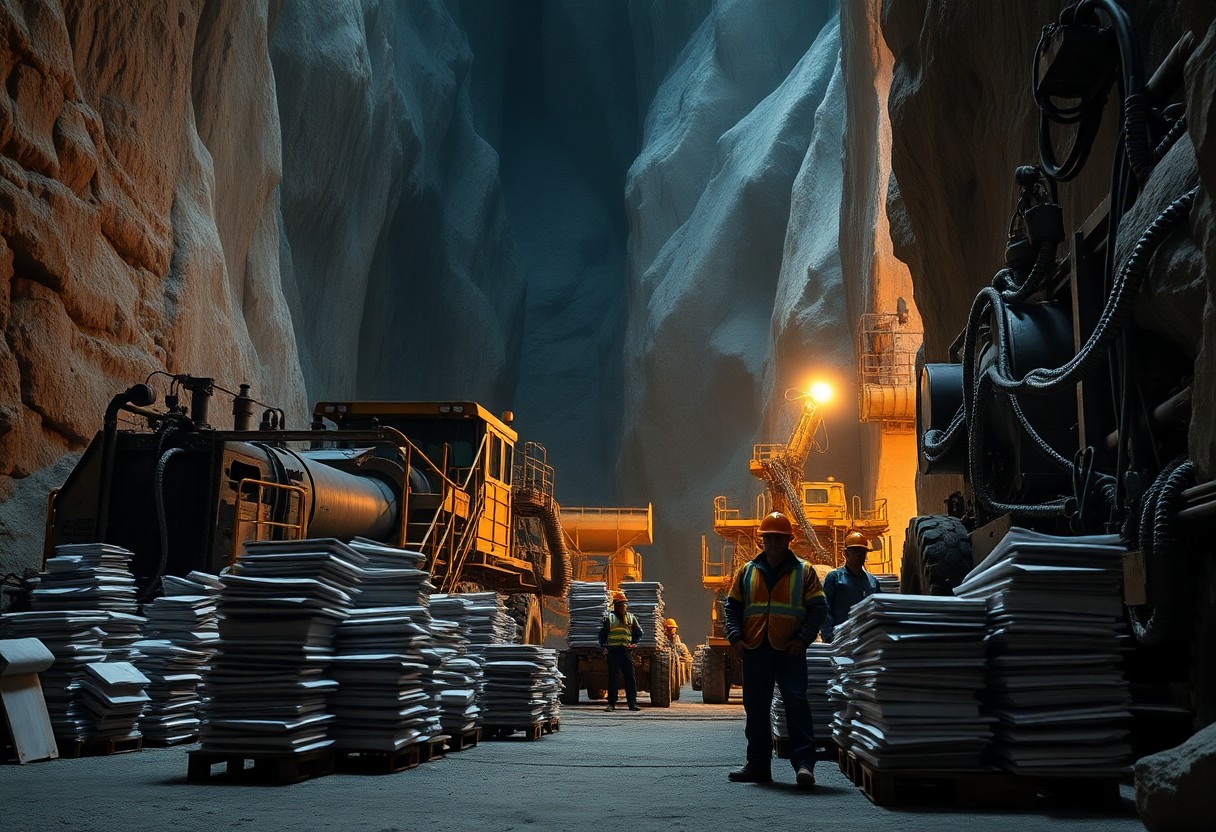Musk describes limestone mine that handles federal workers’ retirement papers
It’s astounding to learn about the old limestone mine in Pennsylvania that processes federal workers’ retirement applications using a manual, paper-based system. Elon Musk shed light on this inefficient operation during a recent event with President Trump, revealing that about 700 workers are deep underground, contending with outdated technology that limits the number of retirements to as few as 10,000 applications a month. This situation underscores the need for significant reform to enhance efficiency in government operations.

Key Takeaways:
- Manual Processing: The limestone mine in Pennsylvania processes federal workers’ retirement applications by hand, leading to significant delays and inefficiencies.
- Outdated System: The facility, operational since 1955, has failed multiple attempts at digitization, leading to ongoing reliance on paper and manual calculations.
- Government Reform: Elon Musk emphasizes the need for major government reform to improve productivity and efficiency in handling federal bureaucratic processes.
To learn more about this story and other “News of the Day” listen to the latest episode of “Just the Truth”
Overview of the Limestone Mine
While exploring the inefficiencies within the federal retirement process, Elon Musk highlighted an old limestone mine in Pennsylvania that plays a significant role in handling retirement applications for federal workers. This facility, described as a “sinkhole of bureaucracy,” processes around 10,000 retirement applications each month, relying completely on manual paperwork.
Location and History
Beside Pittsburgh, the limestone mine is located in Boyers, Pennsylvania, and has been in operation since 1955. Over the decades, multiple attempts to modernize and digitize the retirement processing system have failed, leading to extensive delays and inefficiencies.
Current Operations
At this mine, approximately 700 workers operate more than 230 feet underground to manage federal retirement paperwork. The process is largely outdated, as everything is handled on paper, with applications stored in manila envelopes and cardboard boxes.
This manual handling of applications results in a slow processing pace, with reports indicating that it can take months to complete each request. The mine’s operation is further hampered by the performance of the elevator that transports paperwork, which can break down, preventing retirees from exiting the system. This situation underscores the need for modernized practices, as the existing system has proven to be both inefficient and costly, with previous digitization attempts totaling over $130 million without success.
The Process of Handling Retirement Applications
Some 700 workers are employed in a limestone mine in Boyers, Pennsylvania, tasked with processing approximately 10,000 federal retirement applications each month. This facility exemplifies how federal bureaucracy can operate in unexpected environments, relying on manual methods to manage what should be a streamlined process.
Manual Processing System
At this facility, the retirement applications are handled entirely by hand. Each document is meticulously processed using paper, leading to significant delays as applications are stored in manila envelopes and cardboard boxes.
Efficiency Challenges
An ongoing challenge at this mine is the lengthy processing time, largely due to the outdated manual system. The speed of processing is hindered by the operation of a single mine shaft elevator, which can break down, further delaying retirement approvals.
In addition, the reliance on manual paperwork has resulted in an inefficient system that not only affects employee transitions but also contributes to a backlog of applications. The process has been described as a “sinkhole of bureaucracy”, with federal officials recognizing that attempts to digitize and modernize have largely failed—costing over $130 million since 1987. With delays that can span months, I see how imperative it is to rethink our approach to handling these processes to enhance productivity and better serve federal employees looking to retire.

Musk’s Involvement
Around the Oval Office, Musk discussed his efforts with DOGE to address significant bureaucratic inefficiencies, highlighting the antiquated methods currently used to manage retirement paperwork. The limestone mine, where over 700 workers process applications by hand, illustrates the need for modernization.
Goals of DOGE
DOGE aims to enhance productivity within federal operations by eliminating waste and promoting efficiency. The organization focuses on transitioning workers from low productivity roles to positions that significantly contribute to the American economy.
Understanding the full scope of DOGE’s mission means recognizing its commitment to not only reform the federal retirement process but also to uncover areas of “waste, fraud, and abuse”. By prioritizing practical solutions over traditional methods, they seek to improve processing times, directly impacting the speed at which federal employees can retire. Musk emphasized that better systems could facilitate a more efficient government, benefitting over 2 million federal employees, ultimately shaping a more productive workforce.
Financial Implications
Your understanding of the financial implications of the federal retirement process is critical, especially after Elon Musk’s revelations about the outdated systems. The handling of retirement applications in an underground limestone mine symbolizes wastefulness that could be costing taxpayers millions. For more insights, check out Wait, are the retirement paperwork of government …
Costs of the Current System
With the current method of processing applications by hand, the federal system could be incurring exorbitant expenses. Reports indicate that the total spending on this inefficient system reached approximately $55.8 million, with multiple failed attempts at reform costing over $130 million since 1987. This outdated practice not only delays retirement but also strains resources.
Attempts at Digitization
Implications of the failed digitization efforts indicate a broader issue within our federal systems. Despite numerous attempts since 1987 to transition to a digital format, each initiative has ultimately failed, demonstrating a significant roadblock in modernization. As Elon Musk pointed out, this means that a manual input system remains in place, leading to slow processing times and a backlog of applications.
System failures highlight the dangers of relying on outdated practices for crucial processes. The reliance on paper-based management in a limestone mine could impede the efficiency of federal worker retirements, ultimately affecting the morale of workers. This not only reflects poorly on government efficiency but also on how taxpayer funds are utilized in managing such imperative processes.

Criticism and Political Reactions
After Elon Musk’s revelation about the use of a Pennsylvania limestone mine to process federal workers’ retirement papers, political reactions have sparked considerable debate. Critics from the Democratic Party argue that the inefficiencies highlighted by Musk reveal a lack of accountability in his approach and the broader need for government reform. They fear that the way in which DOGE operates could undermine necessary public services and further entrench systematic issues rather than resolving them.
Responses from Democrats
About the recent comments made by Musk, Democratic leaders have expressed concerns regarding the implications of his revelations. They contend that by focusing on flashy anecdotes, Musk diverts attention from the larger systemic problems in federal bureaucracy. The emphasis on manual processing, although a valid point of concern, seems to overshadow the importance of maintaining effective public services that serve diverse community needs.
Public Perception of DOGE’s Work
Any discussion surrounding DOGE has generated mixed reactions among the public. While some individuals appreciate Musk’s attempts to streamline government processes and eliminate waste, others view the organization as a disruptive force that may jeopardize necessary federal operations. This tension reflects a larger societal debate about government efficiency versus public service integrity.
Work conducted by DOGE in addressing the antiquated practices at the limestone mine has raised questions about their overall effectiveness. Many people appreciate the idea of modernizing federal operations to speed up processes like processing retirement applications. However, the long history of failed digitization efforts, with over $130 million spent without success, has led to skepticism about whether these changes will genuinely improve service or simply exacerbate existing challenges. Your understanding of the project’s implications is necessary as public sentiment surrounding government reform continues to evolve.
Future Solutions and Reforms
For a lasting impact on federal processes, I believe it’s necessary to explore innovative solutions to the issues highlighted by Elon Musk regarding the ‘Limestone Mine’ That Elon Musk Said Manually … handles retirement paperwork. By digitizing procedures and streamlining workflows, we can significantly reduce inefficiencies and enhance service delivery for federal employees.
Potential Improvements in Federal Processes
Reforms are necessary to transition from outdated systems that rely heavily on manual processes, like the one Musk described. Implementing modern technology and automated systems can expedite retirement application processing, lowering the burden on federal workers and improving overall work satisfaction.
Broader Implications for Federal Efficiency
With the inefficiencies exposed by Musk’s comments, it’s clear that fundamental changes are needed across federal operations. The current practice of processing retirement applications manually can take months, contributing to a backlog that affects thousands. Understanding the financial implications of this inefficiency is vital. For example, the failed attempts to digitize these processes since 1987 cumulatively cost over $130 million, illustrating a severe waste of taxpayer resources. By addressing these flaws, we can not only enhance federal productivity but also boost public trust and accountability within government operations.





Leave a Reply
Want to join the discussion?Feel free to contribute!